By Erika Segerson-Mueller, DNR Invasive Plant Program Specialist, Oshkosh Service Center;
Erika.SegersonMueller@wisconsin.gov or 715-492-0391
With 145 invasive plants regulated under Wisconsin’s Invasive Species Rule NR40, it can be challenging to identify some of these plants while out in the woods.
The task can be further complicated by the presence of native lookalikes, plants that appear very similar to harmful invasive species but benefit wildlife, pollinators and ecosystems in Wisconsin.
To unmask the imposters and correctly identify the invasive plants to be controlled, it’s important to learn a few key characteristics. With a little study and practice, you’ll be able to quickly differentiate between these perplexing pairs.
Here’s how to correctly identify three pairs of commonly confused plants that are in bloom right now.
-
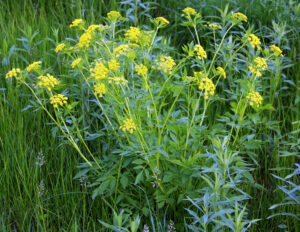
Native golden alexander is often mistaken for invasive wild parsnip. / Photo Credit: Steven Katovich, Bugwood.org

Wild parsnip is often mistaken for native golden alexander. / Photo Credit: Leslie J. Mehrhoff, University of Connecticut, Bugwood.org
Invasive wild parsnip (Pastinaca sativa) vs. native golden alexander (Zizia aurea)
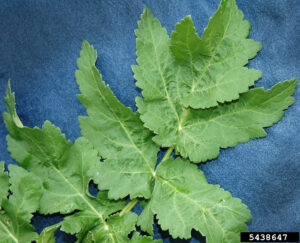
Wild parsnip leaves are coarsely toothed with wrinkled veins. / Photo Credit: Katy Chayka, www.minnesotawildflowers.info, Bugwood.org;
Wild parsnip is an invasive plant of special concern due to the possibility of contact phytophotodermatitis, a skin reaction triggered when the sap of broken parsnip plants (in leaves, stems and flowers) contacts skin and is exposed to sunlight. Reactions can vary from minor rashes to severe burns and scarring, so wild parsnip is a plant to be avoided.
Native golden alexander looks very similar to wild parsnip and the two are often mistaken for one another. Both plants have similar flowers in umbels, or umbrella-shaped flower arrangements.
Golden alexander is significantly smaller than wild parsnip when mature, growing only to three feet in height, with smaller leaves and smaller, looser, uneven flower clusters. Golden alexander also blooms first, while wild parsnip blooms later in the season.
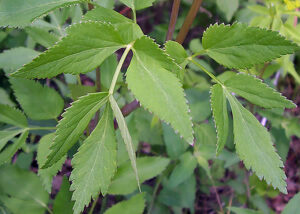
The golden alexander plant has finely toothed leaves with pointed tips. / Photo Credit: Bruce Ackley, The Ohio State University, Bugwood.org
Leaf shape can be used to tell the two apart. Wild parsnip leaves are deep and forked with coarsely toothed edges; golden alexander leaves are finely toothed with pointed tips.
- Invasive non-native honeysuckles (Lonicera) and native American fly honeysuckle (Lonicera canadensis)
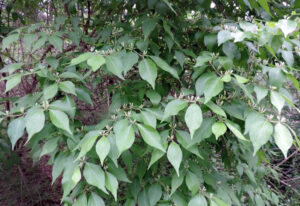
To determine if a honeysuckle is a native or invasive species, break off an older branch and check the pith. / Photo Credit: Richard Gardner, Bugwood.org
There are several types of invasive Eurasian bush honeysuckles in Wisconsin, and it can be easy to think that every honeysuckle you find is invasive and should be controlled. While this would be a simple way to think about honeysuckle, it isn’t the reality. American fly honeysuckle is another similar-looking member of the Lonicera family that is native to Wisconsin.
When in bloom, the flowers of invasive Amur, Bell’s, Morrow’s and Tartarian honeysuckles may help with identification. American fly honeysuckles have pale yellow flowers that occur at the end of each branch and hang down. Without the blooms, you may look for shaggy, grayish-brown bark to help identify an invasive honeysuckle. Identification of the correct species is less important than determining if the bush honeysuckle is, in fact, invasive or if it is a native species.
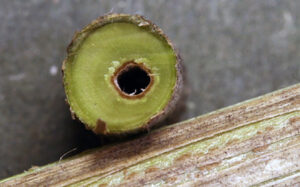
The pith of invasive honeysuckle, seen here, is brown and hollow. / Photo Credit: Chris Evans, University of Illinois, Bugwood.org
The easiest way to determine a non-native honeysuckle from one of the native plants is to do a “pith test.” Break off an older branch of the honeysuckle bush to check the pith (the inner tissue of the branches and stems). If the pith appears solid and white, the shrub is a native honeysuckle; if the pith is brown and/or hollow (like the photo), it is likely one of the invasive bush versions.
- Invasive Dame’s rocket (Hesperis matronalis) vs. native phlox species (Phlox )
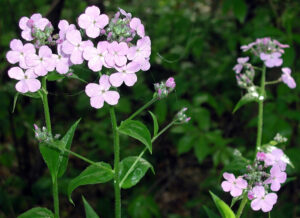
The invasive plant dame’s rocket has four petals per flower. / Photo Credit: Leslie J. Mehrhoff, University of Connecticut, Bugwood.org
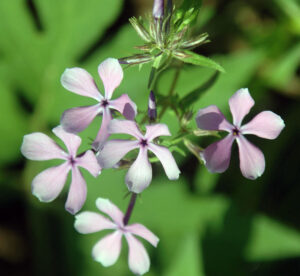
Native phlox species have five petals per flower. / Photo Credit: Chris Evans, University of Illinois, Bugwood.org
Our final pair in Part 1 of this series, dame’s rocket and native phlox species, present very similar appearances. Both have similarly colored flowers that grow in clusters and are in bloom around similar times.
Dame’s rocket invades both wooded and open areas and is often included in wildflower seed mixes. It is often mistaken as a native wildflower, but as an invasive, it contributes to habitat loss for native species.
Looking at the leaves of these plants is a good identifier here. Phlox has leaves that grow mostly opposite (in pairs across from each other) and are untoothed (smooth edges); dame’s rocket has alternating leaves with small teeth on the margins.
An even easier trick to tell these two apart is simply counting petals. The flowers of dame’s rocket have four petals; those in the phlox family have five petals. An easy trick to remember this is that phlox has five letters in its name, and its flowers have five petals as well.
If you encounter one of the named species, use the key identifiers to determine whether the plant is native or invasive. While it may seem easier to simply pull the plant either way, if the plant in question is native, it is likely an important part of its ecosystem and is likely serving as food or habitat for pollinators or wildlife.
Stay tuned for more commonly confused species pairs in Part 2 of this series.
